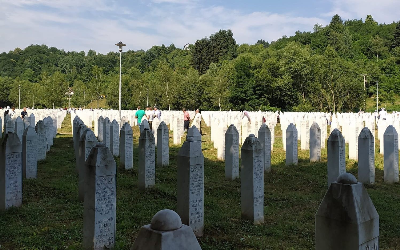
© https://crd.org Photo: Azra Culov
11 липня 2025 року світ вшановує 30-ту річницю геноциду в Сребрениці — трагедії, яка стала одним із найглибших моральних провалів міжнародної спільноти після Другої світової війни. Попри статус «зони безпеки» ООН, у липні 1995 року місто в східній Боснії було захоплене боснійсько-сербськими силами. За кілька днів там відбулася системна розправа: понад 8 000 босняцьких чоловіків і хлопців (від 10 років) були страчені, ще тисячі — депортовані або зникли безвісти. Сьогодні юридично доведено: Сребрениця — не окремий епізод, а завершальна ланка кампанії етнічного очищення під час боснійської війни. Міжнародний трибунал для колишньої Югославії (ICTY), Міжнародний суд ООН і національні суди визнали вбивства геноцидом. Загалом засуджено 54 осіб, які отримали понад 780 років ув'язнення, зокрема кілька довічних строків. Проте правосуддя залишається неповним: багато виконавців досі уникають відповідальності, а частина суспільства — особливо в регіоні — заперечує встановлені судом факти. Попри судові рішення, заперечення геноциду в Боснії й сьогодні є політичним інструментом. У сусідніх країнах публічне вихваляння воєнних злочинців та ревізія історії зберігаються як політична риторика. Це поглиблює травму родин жертв і унеможливлює повноцінне примирення. Символом пам’яті залишається «Квітка Сребрениці» — біло-зелена емблема, що стала ознакою гідності й спротиву забуттю. У 2025 році в Меморіальному центрі Поточарі, поблизу Сребрениці, відбулися жалобні церемонії, до яких долучилися делегації з понад 50 країн, а також члени родин жертв. Під час церемонії було поховано ще 14 новоідентифікованих жертв — останки яких нещодавно знайшли в масових похованнях.
30 Years After Srebrenica: A Memory That Demands Responsibility
On July 11, 2025, the world marks the 30th anniversary of the Srebrenica genocide — a tragedy widely recognized as one of the most profound moral failures of the international community since World War II. Despite being declared a UN "safe area," the town of Srebrenica in eastern Bosnia fell to Bosnian Serb forces in July 1995. Over the course of just a few days, more than 8,000 Bosniak men and boys — some as young as ten — were systematically executed, while thousands more were deported or disappeared. Today, the events of Srebrenica are legally recognized not as an isolated atrocity, but as the culmination of a broader campaign of ethnic cleansing during the Bosnian War. The International Criminal Tribunal for the former Yugoslavia (ICTY), the International Court of Justice (ICJ), and national courts have all classified the massacre as genocide. In total, 54 individuals have been convicted, receiving over 780 years of combined prison sentences, including several life terms. Yet justice remains incomplete. Many perpetrators have never been held accountable, and in parts of the region, judicially established facts continue to be denied. Genocide denial — used as a political tool — remains widespread. In some neighboring countries, public glorification of convicted war criminals and historical rev isionism persist as part of mainstream rhetoric. This deepens the trauma of victims' families and obstructs any genuine process of reconciliation. The white-and-green "Srebrenica Flower" has become a symbol of remembrance, dignity, and resistance to forgetting. In 2025, commemorations at the Potočari Memorial Centre near Srebrenica gathered delegations from more than 50 countries, alongside survivors and families of the victims. During the ceremony, 14 newly identified victims — whose remains were recently recovered from mass graves — were laid to rest.

©
1240